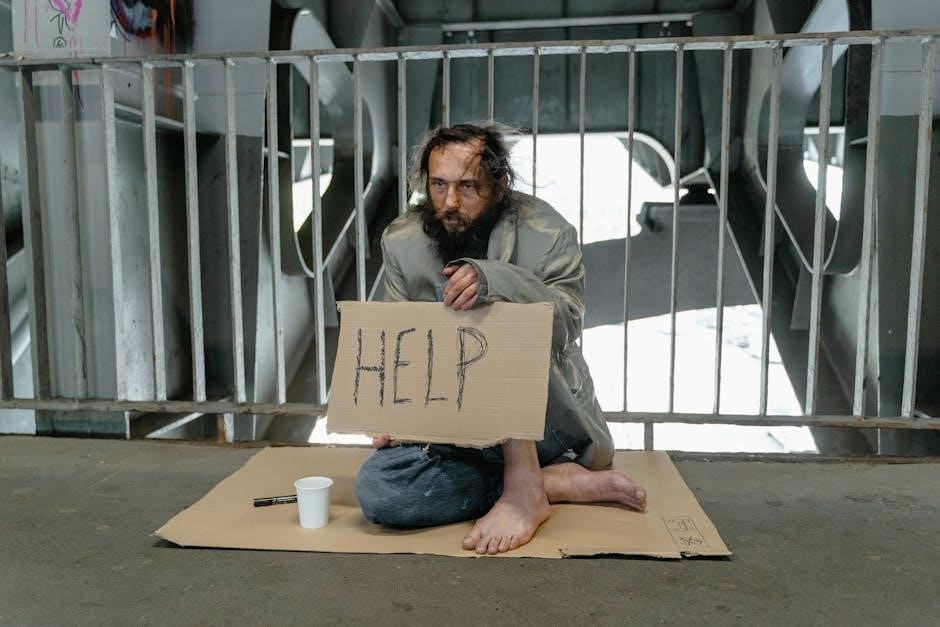“Poor Economics”, by Banerjee and Duflo, presents a groundbreaking analysis of global poverty.
The PDF version, available on Semantic Scholar, details their research and challenges conventional wisdom.
Published in 2011, it offers a radical rethinking of effective poverty alleviation strategies.
Authors: Abhijit V. Banerjee and Esther Duflo
Abhijit V. Banerjee and Esther Duflo, the authors, revolutionized development economics through rigorous research.
Their work, detailed in the “Poor Economics” PDF, emphasizes evidence-based solutions.
They meticulously analyze data from various countries, including India, Indonesia, and Bangladesh.
Their findings challenge traditional approaches to poverty reduction, earning them the Nobel Prize.
Core Argument: A Radical Rethinking of Poverty
“Poor Economics”, accessible as a PDF, argues against sweeping generalizations about poverty.
Banerjee and Duflo advocate for a nuanced understanding, focusing on specific, localized problems.
They challenge the “big push” strategy, emphasizing small, targeted interventions.
The book’s core is a call for empirically-driven policies, dismantling conventional wisdom about the poor.
The Traditional Approaches to Poverty Reduction
“Poor Economics”, found as a PDF, critiques traditional poverty reduction methods.
It questions broad macroeconomic policies and the efficacy of large-scale interventions like those proposed by Jeffrey Sachs.
The Role of Macroeconomic Policies
“Poor Economics”, accessible as a PDF, challenges the assumption that macroeconomic policies alone effectively address poverty.
The authors, Banerjee and Duflo, argue these “big picture” approaches often lack nuance, failing to consider the specific, localized challenges faced by impoverished individuals and households.
They advocate for micro-level interventions, grounded in empirical evidence, rather than relying solely on top-down economic strategies.
The “Big Push” Strategy (Jeffrey Sachs)
“Poor Economics”, available as a PDF, critically examines Jeffrey Sachs’ “Big Push” strategy.
Banerjee and Duflo, while acknowledging the intent, question the effectiveness of large-scale, simultaneous investments without understanding local constraints.
Their research suggests targeted interventions, informed by Randomized Controlled Trials, yield more sustainable results than broad, sweeping economic overhauls.
The Randomized Controlled Trial (RCT) Methodology
“Poor Economics”, accessible as a PDF, champions the use of RCTs.
This rigorous methodology, highlighted throughout the book, provides evidence-based insights into poverty alleviation.
Why RCTs are Crucial in Poverty Research
“Poor Economics”, found as a PDF resource, emphasizes RCTs as vital for understanding poverty’s complexities.
Traditional approaches often lacked concrete evidence; RCTs, through controlled experiments, isolate specific interventions.
This allows researchers – like Banerjee and Duflo – to determine what truly works, moving beyond assumptions. The PDF showcases how RCTs offer a robust, data-driven path to effective policy;
Examples of RCTs Featured in the Book
The “Poor Economics” PDF details impactful RCTs, such as distributing bed nets to combat malaria, demonstrating a significant health improvement.
Another example involves evaluating the impact of providing fertilizer subsidies to farmers.
These studies, outlined in the PDF, showcase how targeted interventions, rigorously tested via RCTs, can effectively address specific poverty-related challenges in contexts like India and Indonesia.

Consumption and Savings of the Poor
The “Poor Economics” PDF challenges myths about spending, revealing the poor don’t squander resources.
They prioritize essential needs and demonstrate careful savings habits.
Dispelling Myths About Poor People’s Spending
“Poor Economics” PDF dismantles common misconceptions regarding how impoverished individuals allocate their limited funds.
The authors demonstrate, through rigorous research, that the poor aren’t reckless spenders.
Instead, they make rational choices, prioritizing necessities like health and education, even amidst extreme financial constraints, and often exhibit surprisingly responsible financial behavior.
The Importance of Small Amounts of Credit
The “Poor Economics” PDF highlights the significant impact of even modest credit access for impoverished populations.
Banerjee and Duflo’s research reveals that small loans, unlike “big push” strategies, can empower individuals to invest in income-generating activities.
These microloans facilitate entrepreneurship and improve livelihoods, challenging traditional lending paradigms.

Health and Education Investments
The “Poor Economics” PDF demonstrates that investments in health – like bed nets for malaria – and education yield substantial returns.
These targeted interventions significantly improve well-being.
Bed Nets and Malaria Prevention
“Poor Economics” PDF highlights the surprisingly low uptake of effective preventative measures, even when free.
The authors detail how providing bed nets dramatically reduces malaria incidence, yet usage requires behavioral understanding.
Simply distributing nets isn’t enough; encouraging consistent use through education and addressing concerns is crucial for maximizing impact on public health outcomes.
Schooling and Private vs. Public Education
The “Poor Economics” PDF examines schooling choices, revealing that even poor families invest in education, but face significant hurdles.
The book details how private schools, despite higher costs, often deliver better learning outcomes due to teacher presence and effort.
This challenges assumptions about solely increasing public school funding, highlighting the need for improved quality and accountability across all educational settings.

The Role of Microfinance
“Poor Economics’ PDF investigates microfinance, specifically microcredit, and its impact on borrowers;
The authors analyze MFIs like Spandana, revealing both benefits and limitations of this approach to poverty reduction.
Microcredit and its Impact on Borrowers
“Poor Economics’ PDF examines how microcredit affects the poor, noting that while it allows some to invest and increase income, it doesn’t dramatically transform lives.
Borrowers often use funds for consumption or existing businesses, not necessarily expansion.
The book details how interest rates and repayment pressures can create challenges.
Limitations and Criticisms of Microfinance (MFIs)
The “Poor Economics” PDF reveals that MFIs aren’t a universal solution; high interest rates can burden borrowers, and multiple loans can lead to default.
Muhammad Yunus’ model faced scrutiny, as rapid expansion sometimes compromised responsible lending.
The book highlights the need for careful evaluation of microfinance’s impact.

Agriculture and Rural Poverty
The “Poor Economics” PDF examines fertilizer subsidies and farmer behavior, revealing complexities in rural economies;
Rural lending challenges and the impact on agricultural livelihoods are explored.
Fertilizer Subsidies and Farmer Behavior
“Poor Economics’ PDF details how fertilizer subsidies, while intended to help, often lead to unintended consequences.
Farmers don’t always utilize them effectively, and the book analyzes why, questioning the simple assumption that lower costs automatically increase agricultural productivity.
The research highlights behavioral nuances impacting subsidy uptake and usage in rural contexts.
The Challenges of Rural Lending
The “Poor Economics” PDF explores why traditional rural lending faces significant hurdles.
Farmers often lack collateral, and formal financial institutions struggle with information asymmetry and high transaction costs in remote areas.
The book details how moneylenders persist, despite high interest rates, due to accessibility and flexibility.

The Labor Market and Poverty
“Poor Economics” PDF reveals how the poor navigate volatile labor markets.
Seasonal work and limited opportunities contribute to unstable earnings, hindering long-term economic advancement.
The book analyzes these dynamics in detail.
Understanding Earnings and Employment
The “Poor Economics” PDF meticulously examines how the poor earn a living, revealing complex realities.
Earnings are often surprisingly low and highly variable, influenced by factors like seasonal work and limited skill sets.
Banerjee and Duflo demonstrate that simply providing employment isn’t enough; the quality of jobs significantly impacts poverty reduction, as detailed in the book’s analysis.
The Impact of Seasonal Work
The “Poor Economics” PDF highlights the precariousness of seasonal work for impoverished populations.
Reliance on these jobs creates income volatility, forcing families into cycles of debt and hindering long-term investment.
Banerjee and Duflo’s research, detailed within the PDF, shows how this impacts consumption smoothing and overall economic stability for vulnerable households.
The Political Economy of Poverty
“Poor Economics’ PDF reveals how corruption and weak institutions exacerbate poverty.
These factors, explored by Banerjee and Duflo, impede effective resource allocation and hinder progress.
Corruption and its Effects
“Poor Economics’ PDF meticulously details how corruption systematically undermines poverty reduction efforts.
Banerjee and Duflo demonstrate that diverted funds, intended for crucial services like health and education, directly impact the poor.
This creates a cycle where vulnerable populations are consistently denied opportunities, reinforcing existing inequalities and hindering sustainable development. The PDF provides compelling evidence of these detrimental effects.
The Role of Institutions
The “Poor Economics” PDF emphasizes that strong, accountable institutions are vital for effective poverty alleviation.
Banerjee and Duflo argue that well-functioning governance structures ensure resources reach those who need them most, fostering sustainable improvements.
Weak institutions, conversely, exacerbate poverty through mismanagement and lack of transparency, hindering progress. The PDF highlights the crucial link between institutional quality and poverty reduction outcomes.

Behavioral Economics and Poverty Traps
The “Poor Economics” PDF explores how psychological factors and “poverty traps” hinder the poor.
It details the “S-shape” of poverty, showing how small initial disadvantages can become self-perpetuating cycles.
The “S-Shape” of Poverty
“Poor Economics” PDF illustrates the “S-shape” concept, where initial disadvantages create a reinforcing cycle.
Small setbacks, like lacking initial capital, can escalate, making escape incredibly difficult.
This PDF details how these traps aren’t simply about a lack of resources, but also psychological barriers and behavioral patterns.
It’s a crucial element in understanding persistent poverty.
Psychological Barriers to Improvement
The “Poor Economics” PDF reveals how psychological factors hinder the poor’s ability to improve their lives.
These aren’t deficits, but rational responses to consistent uncertainty and scarcity.
The PDF details how limited bandwidth affects decision-making, and how present bias leads to underinvestment in the future.
Understanding these barriers is vital for effective interventions.
Geographic Scope of Research
The “Poor Economics” PDF showcases research across India, Indonesia, and Bangladesh.
It also utilizes an eighteen-country data set for broader analysis.
Case Studies: India, Indonesia, Bangladesh
“Poor Economics” PDF extensively features detailed case studies from India, Indonesia, and Bangladesh.
These nations provided crucial real-world contexts for the authors’ Randomized Controlled Trials (RCTs).
The PDF illustrates how specific interventions impacted lives within these diverse cultural and economic landscapes, forming the core of their evidence-based approach.
The Eighteen-Country Data Set
The “Poor Economics” PDF reveals the authors’ analysis extended beyond individual case studies, utilizing data from an eighteen-country dataset.
This broad scope allowed for comparative insights into poverty’s nuances.
The PDF demonstrates how this extensive data informed their conclusions, strengthening the book’s arguments and generalizability of findings.

Key Concepts: Calories, Rupees, USD PPP
The “Poor Economics” PDF emphasizes measuring poverty using calories, rupees, and USD PPP.
These metrics, detailed in the PDF, provide context for understanding economic realities.
Measuring Poverty Across Different Contexts
“Poor Economics” PDF highlights the complexities of comparing poverty levels globally.
The authors stress that a uniform standard is insufficient, advocating for context-specific analysis.
Understanding local prices – like rupees or rupiah – and utilizing USD PPP are crucial, as detailed in the PDF, for accurate assessments.
The Importance of Purchasing Power Parity
The “Poor Economics” PDF emphasizes Purchasing Power Parity (PPP) as vital for meaningful poverty comparisons.
Simply converting currencies doesn’t reflect actual living standards.
The book, accessible as a PDF, demonstrates how calories and local rupees reveal more than nominal USD values, offering a nuanced understanding of economic hardship.
Criticisms and Debates Surrounding “Poor Economics”
The “Poor Economics” PDF faced critique from William Easterly and Jonathan Robinson.
Debates center on methodology and generalizability of findings presented within the PDF.
Responses to William Easterly’s Critique
Banerjee and Duflo, in responses accessible alongside the “Poor Economics” PDF, addressed Easterly’s concerns regarding the limited scope of their RCT approach.
They argued that focusing on specific, localized interventions, as detailed in the PDF, provides actionable insights.
They maintained that while not a universal solution, these micro-level studies build a foundation for broader policy improvements.
The Debate with Jonathan Robinson
Details of the debate with Jonathan Robinson, often referenced when discussing the “Poor Economics” PDF, center on the scalability of RCT findings.
Robinson questioned whether successful interventions, documented within the PDF, could be effectively replicated on a larger, national scale.
Banerjee and Duflo countered by emphasizing the iterative nature of policy development and the importance of context-specific adaptation.

Impact and Legacy of the Book
“Poor Economics”, accessible as a PDF, profoundly influenced development economics.
Its emphasis on RCTs and nuanced understanding of poverty led to the authors receiving the Nobel Prize.
Influence on Development Economics
“Poor Economics”, readily available as a PDF, shifted the field towards evidence-based policymaking.
The book’s rigorous Randomized Controlled Trials (RCTs) methodology became a cornerstone of modern development research, influencing organizations like the World Bank.
It encouraged a move away from “big push” strategies, advocating for targeted interventions based on specific contextual understanding of poverty.
Recognition and Awards (Nobel Prize)
The impactful research presented in “Poor Economics”, accessible as a PDF, culminated in significant recognition for its authors.
Abhijit V. Banerjee and Esther Duflo were jointly awarded the 2019 Nobel Memorial Prize in Economic Sciences, alongside Michael Kremer.
This prestigious award acknowledged their experimental approach to alleviating global poverty, stemming directly from the book’s core principles.

Accessing the “Poor Economics” PDF
The “Poor Economics” PDF is readily available through Semantic Scholar.
Purchasing options for physical editions and e-books are also widely accessible online through various retailers.
Availability on Semantic Scholar
Semantic Scholar provides free access to the “Poor Economics” research paper in PDF format;
This platform, a science and medical literature search engine, hosts the inproceedings document by Jameel (2014).
Researchers and readers can easily download and explore Banerjee and Duflo’s pivotal work, furthering understanding of poverty alleviation strategies.
Purchasing Options and Editions
“Poor Economics” is available for purchase in various editions.
The 2011 edition, a 499-page book from Random House India, originally cost Indian Rupees 279.00.
Google Books also lists the title, while the PDF version can be accessed through academic databases and potentially purchased digitally from online retailers.